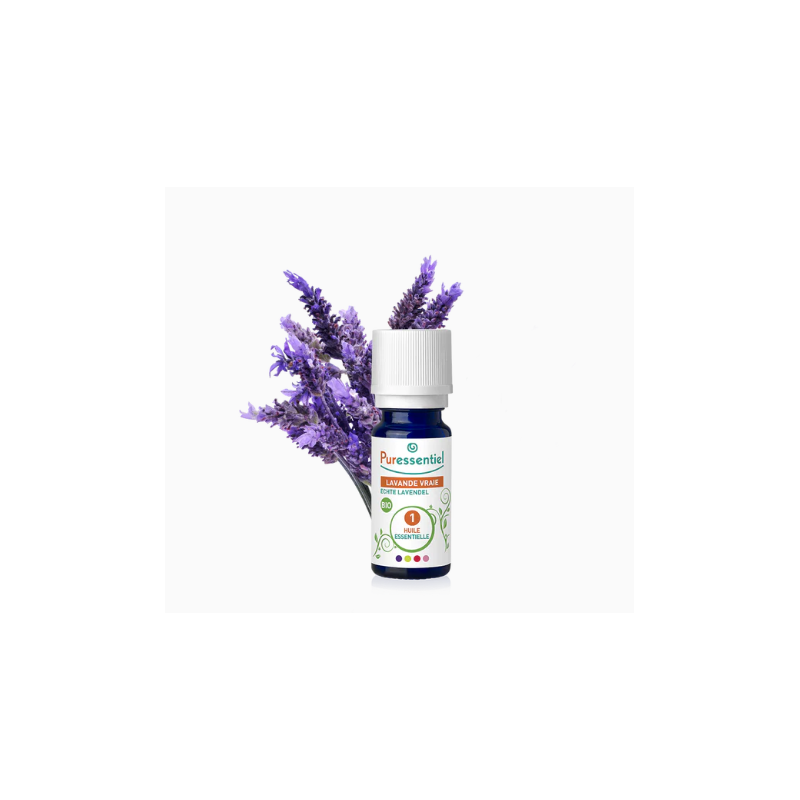At the base of many perfumes, the essential oil of true lavender has a delicate scent. Naturally present in the north of the Mediterranean basin, true or officinal lavender has also been cultivated for several years in Bulgaria, Ukraine and even Australia. In France, the four producing departments of the Midi alone represent some 20,000 cultivated hectares.
Botanical information
Lavandula angustifolia
Botanical family: Lamiaceae
Producing organ: flowering tops
Chemotype: linalyl acetate, linalool.
Main properties
Superb anti-stress, calming agent, sedative, anti-depressant Heals and restores the skin. Antiseptic (general) And also Muscle relaxant, powerful antispasmodic Pain relief
Main indications
Neural disorders: Apply 2 drops of diluted lavender in 20 drops of vegetable oil (preferably sweet almond oil), and massage along the spine, on the arch of the foot, on the plexus solaire and/or on the inside of the wrists.
Diffuse 40 drops of lavender during the day (to relax) and/or in the evening (to sleep) from a diffuser.
Bath: 10 drops on a tablespoon of base then poured into a hot bath. Relax in the bath for 20 minutes, dry-off without rinsing and go to bed.
Stress: Bath: 20 drops of medicinal lavender EO + 10 drops of mandarin EO in 4 cap-fulls or 20 neutral base pressures. Pour into a warm bath. This can be done every evening if necessary.
Sun burn: Massage: 6 drops of medicinal lavender in 5 ml of St John’s Wort vegetable oil (*). Massage in the evening. (*) A photo sensitiser vegetable oil should not be exposed to the sun or UV rays in the 3 hours following its application.
Skin: Apply 2-3 pure drops onto the irritating or infected area.
Other very good uses Cramps, contractions and muscular spasms Digestive spasms Rheumatisms Anti-lice
Pains: Apply 2-4 drops, diluted in a tablespoon of vegetable oil, directly onto the painful area (massage onto the stomach if digestion pain).
Bath: 10 drops of neutral base on a tablespoon or milk and pour into a hot bath. Relax in the bath for 20 minutes, dry-off without rinsing and go to bed.
Digestive spasms: Swallow 2 drops on either a neutral tablet, in a teaspoon of olive oil or on quarter of a sugar cube 3 times per day.
Lice - “shock” making! Apply 25 drops of tea-tree mixed with 25 drops of diluted lavender in 100ml of sweet almond oil. Put half of the mixture on to wet hair just before shampooing then comb through. Put the rest of the mixture onto the scalp. Comb again section by section, from the scalp to the ends of your hair from the forehead to the neck. Cover the hair with cling film and leave in place for 2 hours. Rinse, shampoo twice and then rinse well again. Use the anti-lice comb once more to be certain all lice have gone. Repeat this 15 days later to make sure any lice have not reappeared.
Other uses
Lavender is an omnipotent and multi-purpose! It flavours dishes (have you ever tried fruit salad or crème brulée with lavender?), fragrances wardrobes (put some drops onto the wood), laundry (spray water with lavender essential oil), deodorises a room (some drops of lavender on a saucer), etc.
Contraindication
Like all essential oils the lavender oil is not allowed during the first 3 months of pregnancy. It is also not to be used during breast feeding.


 100% secure payment, Customer Satisfaction
100% secure payment, Customer Satisfaction
 Order shipped within 24 hours from Monday to Friday*
Order shipped within 24 hours from Monday to Friday*



